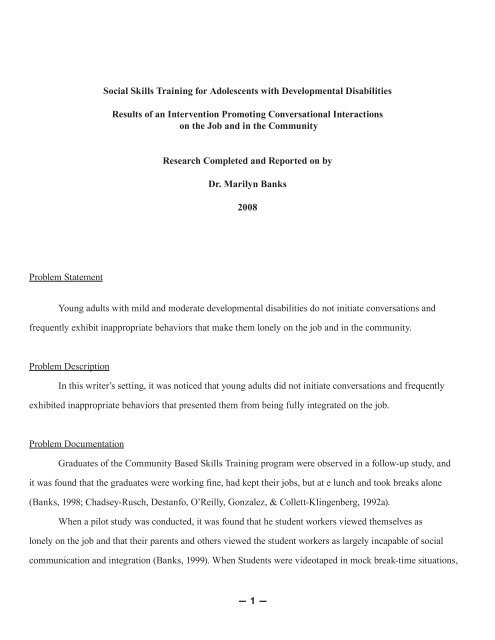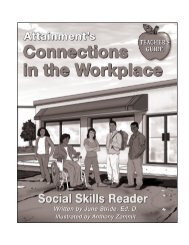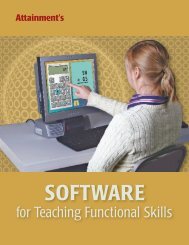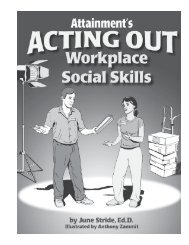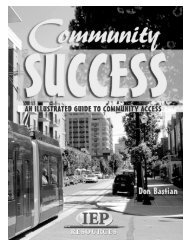— — Social Skills Training for Adolescents with Developmental ...
— — Social Skills Training for Adolescents with Developmental ...
— — Social Skills Training for Adolescents with Developmental ...
You also want an ePaper? Increase the reach of your titles
YUMPU automatically turns print PDFs into web optimized ePapers that Google loves.
Problem Statement<br />
<strong>Social</strong> <strong>Skills</strong> <strong>Training</strong> <strong>for</strong> <strong>Adolescents</strong> <strong>with</strong> <strong>Developmental</strong> Disabilities<br />
Results of an Intervention Promoting Conversational Interactions<br />
on the Job and in the Community<br />
Research Completed and Reported on by<br />
Dr. Marilyn Banks<br />
2008<br />
Young adults <strong>with</strong> mild and moderate developmental disabilities do not initiate conversations and<br />
frequently exhibit inappropriate behaviors that make them lonely on the job and in the community.<br />
Problem Description<br />
In this writer’s setting, it was noticed that young adults did not initiate conversations and frequently<br />
exhibited inappropriate behaviors that presented them from being fully integrated on the job.<br />
Problem Documentation<br />
Graduates of the Community Based <strong>Skills</strong> <strong>Training</strong> program were observed in a follow-up study, and<br />
it was found that the graduates were working fine, had kept their jobs, but at e lunch and took breaks alone<br />
(Banks, 1998; Chadsey-Rusch, Destanfo, O’Reilly, Gonzalez, & Collett-Klingenberg, 1992a).<br />
When a pilot study was conducted, it was found that he student workers viewed themselves as<br />
lonely on the job and that their parents and others viewed the student workers as largely incapable of social<br />
communication and integration (Banks, 1999). When Students were videotaped in mock break-time situations,<br />
<strong>—</strong> <strong>—</strong>
it was found that most of the students remained passive during conversations and did not initiate greetings,<br />
comments or questions. Structured observations of students during work periods showed<br />
that students initiated conversations regarding needs <strong>for</strong> more materials and help in per<strong>for</strong>ming tasks, but little<br />
non-task-related conversation was observed.<br />
When parents were interviewed, some expressed that they thought that these students were incapable of learning<br />
skills that would improve social competence. The student workers did not initiate greetings to their supervisors<br />
and others and only responded when others greeted them. It was observed that others often talked <strong>for</strong> them and<br />
did not expect them to initiate conversations.<br />
The pilot study revealed that workers <strong>with</strong> disabilities did not have a repertoire of appropriate initiations<br />
and behaviors, but that they needed to be taught greetings, introductions, probing get-acquainted questions,<br />
compliments, and comments (Banks, 1999).<br />
Although inclusion is now being practiced in school settings, many students <strong>with</strong> disabilities still eat lunch<br />
<strong>with</strong> similar students. Their social contacts are teachers, paraprofessionals, and peers <strong>with</strong> disabilities. This<br />
limits their chances to build a foundation <strong>for</strong> social integration in the work world. Although all workers <strong>with</strong><br />
disabilities have unique needs, conversational interactions <strong>for</strong> job-related needs and social needs seem to be<br />
universal. The intervention strategy was specifically designed to:<br />
(a) Give the student workers <strong>with</strong> disabilities a repertoire of acceptable<br />
subjects <strong>with</strong> which to initiate conversations rather than being passive observers.<br />
(b) Extinguish behaviors that interfere <strong>with</strong> successful social integration.<br />
(c) Provide opportunities <strong>for</strong> social integration and use of skills learned.<br />
(d) Provide opportunities <strong>for</strong> workers <strong>with</strong> disabilities to build friendships on the job.<br />
The question to be answered was: If workers <strong>with</strong> disabilities were given opportunities to integrate on<br />
the job, would they initiate more conversations and would they express that they had more friends after<br />
the intervention?<br />
Settings and Participants<br />
There were seven participants in the pilot study who were mildly or moderately disabled high school<br />
students ages 20-22 years. The students were in their last year of job skills training and were being<br />
prepared to enter the world of work. All of the students were participating in the Students in Educational<br />
Transition <strong>for</strong> Supported Employment (S.E.T.S.) and met in a classroom setting each morning be<strong>for</strong>e<br />
<strong>—</strong> <strong>—</strong>
going out <strong>for</strong> five-hour unpaid work sessions in the community. Students were trained daily by certified<br />
special education teachers as well as co-workers at the various businesses. The businesses were well-<br />
known retail, food service and factory situations.<br />
Measurements Employed<br />
The Worker Loneliness Questionnaire was administered to find out how students viewed<br />
themselves at work and how they described their leisure pursuits. This questionnaire consists of six<br />
questions on Aloneness factors, seven questions on <strong>Social</strong> Dissatisfaction, and seven questions on<br />
Interest and Leisure Pursuits.<br />
The Checklist of Adaptive Living <strong>Skills</strong> was filled out by parents, job partners, and job trainers<br />
be<strong>for</strong>e and after the intervention. All students were videotaped in a mock-break time situation <strong>with</strong> co-workers<br />
who did not have disabilities. The videotaping took place be<strong>for</strong>e students had lessons in conversational<br />
initiations and they<br />
were not told the purpose of the video. Co-workers were told not to prompt the students but to have get-<br />
acquainted-type conversations. The co-workers were not told that the facilitator was looking <strong>for</strong> initiations<br />
on the part of the student workers. The co-workers who were chosen <strong>for</strong> the first taping were not friends of<br />
the students and were not necessarily the same co-workers chosen <strong>for</strong> the final taping five months later. The<br />
criterion <strong>for</strong> mastery of initiations was five unsolicited initiations or comments on the part of the student in a<br />
five-minute period.<br />
Methods<br />
The facilitator developed self-managed check sheets that were designed to cover conversational subjects.<br />
These sheets were used to guide weekly lessons and contained picture cues and simple words telling the<br />
students what to do in order to start a conversation. Students engaged in role-playing <strong>with</strong> one another and<br />
the teachers in order to have guided practice <strong>for</strong> each lesson. Students were instructed to carry the sheets <strong>with</strong><br />
them to work and to circle a number on the sheet each time that they successfully started a conversation on a<br />
designated subject. The skill sheets covered such subjects as such as finding out the names of co-workers, being<br />
the first to say hello, talking about the weather, talking about pets, and other subjects that were found to be<br />
talked about at work (Chadsey-Rusch & Gonzalez, 1988).<br />
<strong>—</strong> <strong>—</strong>
Results<br />
The post-test filming showed the range of initiations from 1 to 19.3 and the median score was 7.3.<br />
Although subjects did very little initiating at the baseline, they had no trouble replying to questions asked<br />
of them. The results suggest that these student workers <strong>with</strong> disabilities had less trouble responding to<br />
conversations than initiating conversations. During the post-test interviews, co-workers were directed to<br />
allow the students to “talk as much as possible and to refrain from prompting them or asking them too many<br />
questions.” The decrease in mean replies after intervention (27.87 to 12.32 on two trials) suggests that this<br />
technique was effective. This also agrees <strong>with</strong> the research that shows that others often talk <strong>for</strong> people <strong>with</strong><br />
disabilities and that co-workers need to be in<strong>for</strong>med of the kind of support needed by peoples <strong>with</strong> disabilities<br />
(Mank et al., 1999). Frea et al. (1997) suggested that people <strong>with</strong> disabilities should not be allowed to escape<br />
social demands. This escape often takes place through passive involvement in conversations.<br />
The results on the Co-Worker Involvement Index showed a mean pretest score of 7.00 (SD = 1.04) and<br />
the mean on the post-test score was 11.08 (SD = 2.8). One student stayed the same and one student lost a point.<br />
All other students gained between one and eight points.<br />
The Checklist of Adaptive Living <strong>Skills</strong> yields levels of Sensitivity, Insight, and Communication. The<br />
Communication portion was of particular interest in this study because that is the portion that measures the<br />
action the individual takes as a result of applying the first two skills of Sensitivity and Insight. The mean score<br />
on the pretest <strong>for</strong> Communication was 18.5 (SD = 6.52) and the mean score on the post-test was<br />
23.9 (SD = 8.34). All students met the expected outcome <strong>for</strong> this measure. The parent post-test indicated that<br />
all parents of the participants viewed their young adults as having made gains in the social awareness area as a<br />
result of the intervention.<br />
Discussion<br />
When the results of all of the measures used in this research are considered, it shows an overlap of<br />
interactions needed to teach non-work-related conversation to people <strong>with</strong> disabilities. It shows that it is best<br />
<strong>for</strong> training to take place in “real time” and in “real places” in order <strong>for</strong> cognitive approaches to be effective.<br />
A support network was <strong>for</strong>med between the parents, the teacher, and the co-workers that created the right<br />
atmosphere <strong>for</strong> social success (O’Conner, 1983). This ecological approach is consistent <strong>with</strong> Greenspan’s model<br />
that shows correlation between personal competencies and community adjustment outcomes (Black et al., 1997).<br />
These personal affect the quality-of-life <strong>for</strong> special students after graduation and help them <strong>for</strong>m stable social<br />
<strong>—</strong> <strong>—</strong>
elationships that are not necessarily dependent on cognitive competence alone. I.Q. is not a predictor of the<br />
number of friendships a person might develop (O’Conner, 1983).<br />
Recommendations<br />
The recommendations are that specific conversational interaction training be included as a part of<br />
instruction in special education career preparation classes beginning in middle school. It is apparent from this<br />
research that people <strong>with</strong> developmental disabilities can benefit from a repertoire of conversations that will help<br />
them successfully<br />
integrate on the job and in the community. This solution could be furthered by educating parents as to the need<br />
<strong>for</strong> fostering conversational skills at an early age and the need to have high expectations <strong>for</strong> their children.<br />
References<br />
Asher, S. R., Hymel, S., & Renshaw, P. D., (1984). Peer relations and the development of social skills.<br />
Child Development, 55, 1456-1464.<br />
Asher, S. R., Parkhurst, J. T., Hymel, S., & Williams, G. A. (1990). Peer rejection and lonliness in<br />
children. In S. R. Asher & J. D. Coi (Eds.), Peer Rejection in childhood (253-273). New York: Cambridge<br />
University Press.<br />
Bambara, L. M., & Ager, C. (1992). Using self-scheduling to promote self-directed leisure activity in<br />
home and community settings. The Journal of the Association <strong>for</strong> Persons <strong>with</strong> Severe Handicaps, 17(2), 67-76.<br />
Bandura, A. (Ed.). (1977). <strong>Social</strong> Learning Theory, (160-189). New Jersey: Prentice Hall.<br />
Banks, M. (1998). A follow-up study of graduates of a work training program <strong>for</strong> high school students<br />
<strong>with</strong> disabilities. Unpublished manuscript, Nova Southeastern University, Ft. Lauderdale, Florida.<br />
Banks, M. (1999). Program evaluation/design and intervention: Conversational interaction skills on the<br />
job. Unpublished manuscript. Nova Southeastern University, Ft. Lauderdale, Florida.<br />
Berg, W. K., Wacker, D. P., & Flynn, T. H. (1986). Teaching generalization and maintenance of<br />
work behavior. In Rusch, F. R. (Ed.), Generalizing and maintaining work behavior: Competitive issues and<br />
employment strategies (145-159). Baltimore: Paul H. Brookes Publishing Co.<br />
Black, R. S., & Longone, J. (1997). <strong>Social</strong> awareness and transition to employment <strong>for</strong> adolescents <strong>with</strong><br />
mental retardation. Remedial and Special Education, 18(4), 214-222, 232.<br />
Black, R. J. & Rojewski, J. W. (1998). The role of social awareness in the employment success of<br />
adolescents <strong>with</strong> mild mental retardation. Education and <strong>Training</strong> in Mental Retardation and <strong>Developmental</strong><br />
Disabilities, 33(2), 144-161.<br />
<strong>—</strong> <strong>—</strong>
Brown, W.H., & Odom, S.I. (1994). Strategies and tactics <strong>for</strong> promoting generalization and maintenance<br />
of young children’s social behavior. Research in <strong>Developmental</strong> Disabilities, 15(2), 99-118.<br />
Bullis, M., & Foss, G. (1986). Assessing the employment-related interpersonal competence of mildly<br />
mentally retarded workers. American Journal of Mental Deficiency, 91(1), 43-50.<br />
Burton, C.B. (186). Children’s peer relationships. Current Topics in Early Childhood Education, 7, 2-5.<br />
Butterworth, J. Jr., & Strauch, J. D. (1994). The relationship between social competence and success in<br />
the competitive work place <strong>for</strong> persons <strong>with</strong> mental retardation. Education and <strong>Training</strong> in Mental Retardation<br />
and <strong>Developmental</strong> Disabilities, 29, 118-133.<br />
Calkins, C. F., & Walker, H. M. (1989). Enhancing employment outcomes through habilitation planning<br />
<strong>for</strong> social competence. In W. E. Kiernan, & R. L. Schalock (Eds.), Economics, industry and disability: A look<br />
ahead (153-166). Baltimore: Paul H. Brookes Publishing Co.<br />
Chadsey-Rusch, J. (1992b). Toward defining and measuring social skills in employment settings.<br />
American Journal on Mental Retardation, 96(4), 405.<br />
Chadsey-Rusch, J., DeStanfo, J., O’Reilly, M., Gonzalez, P., & Collett-Klingenberg, L. (1992a).<br />
Assessing the lonliness of workers <strong>with</strong> mental retardation. Mental Retardation, 30(2), 85-92.<br />
Chadsey-Rusch, J., & Gonzalez, P. (1988). <strong>Social</strong> ecology of the workplace: Employers’ perceptions<br />
versus direct observation. Research in <strong>Developmental</strong> Disabilities, 9, 229-245.<br />
Chadsey-Rusch, J., & Gonzalez, P., Tines, J., & Johnson, J.R. (1989). <strong>Social</strong> ecology of the workplace:<br />
Contextual variables affecting social interactions of employees <strong>with</strong> and <strong>with</strong>out mental retardation. American<br />
Journal on Mental Retardation, 94(2), 141-151.<br />
Chadsey-Rusch, J., Karlan, G. R., Riva, M. & Rusch, F. R. (1984). Competitive employment: teaching<br />
conversation skills to adults who are mentally retarded. Mental Retardation,22, 218-225.<br />
Chadsey-Rusch, J., Linneman, D., & Rusch, F. R. (1997). The impact of social integration interventions<br />
and job coaches in work settings. Education and <strong>Training</strong> in Mental Retardation and <strong>Developmental</strong><br />
Disabilities, 32(3), 281-291.<br />
Cheney, D., & Foss, G. (1984). An examination of the social behavior of mentally retarded workers.<br />
Education and <strong>Training</strong> of the Mentally Retarded. 216-221.<br />
Cimera, R. E. (1998). Are individuals <strong>with</strong> severe mental retardation and multiple disabilities costefficient<br />
to serve via supported employment programs? Mental Retardation, 36(4), 280-292.<br />
Cobb County Public Schools (1999). Community Based Vocational <strong>Training</strong> Brochure, Marietta,<br />
Georgia.<br />
Coffey, K. M., & Sears, J. (1996). Educational goals <strong>for</strong> individuals <strong>with</strong> a severe disability: Parental<br />
and professional preferences. Education, 116(4), 550-554.<br />
<strong>—</strong> <strong>—</strong>
Coie, J. D., & Kupersmidt, J.B. (1983). A behavioral analysis of emerging social status in boys’ groups.<br />
Child Development 54, 1400-1416.<br />
Collet-Klingenberg, L., & Chadsey-Rusch J. (1991). Using a cognitive process approach to teach social<br />
skills. Education and <strong>Training</strong> in Mental Retardation, September, 258-270. (This article did not have a volume<br />
number)<br />
Dodge, K. (1983). Behavioral antecedents of peer social status. Child Development, 54, 1386-1399.<br />
Ellis, N. R. (Ed.) (1963). Handbook of Mental Deficiency. New York: McGraw Hill. 325-349.<br />
Fairweather, J. S. (1989). Transition and other services <strong>for</strong> handicapped students in local agencies.<br />
Exceptional Children, 55(4), 315-320.<br />
Ferguson, B., McDonnell, J., & Drew, C. (1993). Type and frequency of social interaction among<br />
workers <strong>with</strong> and <strong>with</strong>out mental retardation. American Journal on Mental Retardation, 97(5), 530-540.<br />
Ford, L., Dineen, J., & Hall, J. (1984). Is there life after placement? Education and <strong>Training</strong> of the<br />
Mentally Retarded, 291-296.<br />
Foss, G., Bullis, M., & Vilhauer, D. (1984). The assessment and training of itnerpersonal competence<br />
in the vocational setting <strong>with</strong> mentally retarded workers. In A. Helpern & M. Fuhrer (Eds.), Functional<br />
Assessment in Rehabilitation (pp. 145-150). Baltimore: Paul H. Brookes Publishing Co.<br />
Frea, W. D., & Hughes, C. (1997). Fucntional analysis and treatment of social-communicative behavior<br />
of adolescents <strong>with</strong> developmental disabilities. Journal of Applied Behavior Analysis, 30(4), 701-704.<br />
Garff, J. T., & Storey, K. (1998). The use of self-management stratgies <strong>for</strong> increasing the appropriate<br />
hygiene of persons <strong>with</strong> disabilities in supported employment settings. Education and <strong>Training</strong> in Mental<br />
Retardation, 33(2), 179-188.<br />
Greenspan, S., Schoultz, B., & Weir, M. M. (1981a). <strong>Social</strong> jodgment and vocational adjustment of<br />
mentally retarded adults. Applied Research in Mental Retardation, 2, 335-346.<br />
Greenspan, S., Schoultz, B., (1981b). Why mentally retarded adults lose their jobs: <strong>Social</strong> competence<br />
as a factor in work adjustment. Applied Research in Mental Retardation, 2, 23-38.<br />
Gresham, F. M. (1981). <strong>Social</strong> skills training <strong>with</strong> handicapped children: A review. A Review of<br />
Education Research, 51, 139-176.<br />
Hagner, D., Butterworth, J., & Keith, G. (1995). Strategies and barriers in facilitating natural supports<br />
<strong>for</strong> employment <strong>for</strong> adults <strong>with</strong> severe disabilities. Journal of the Association <strong>for</strong> Persons <strong>with</strong> Severe<br />
Handicaps, 20(2), 110-120.<br />
Halpern, A. S. (1985). Transition: A look at the foundations. Exceptional Children, 51(6), 479-486.<br />
<strong>—</strong> <strong>—</strong>
Haring, T. G., Blair, R. Lee, M., Breen, C., & Gaylord-Ross, R. (1986). Teaching social language to<br />
moderately handicapped students. Journal of Applied Behavior Analysis, 2(19), 159-171.<br />
Haring, T. G., & Breen, C. G. (1992). A peer-mediated social network intervention to enhance the social<br />
integration of persons <strong>with</strong> moderate and severe disabilities. Journal of Applied Behavior Analysis, 25(2), 319-<br />
333.<br />
Harrison, H., & Love, F. E. (1997). Empowering students <strong>with</strong> disabilities by teaching selfdetermination<br />
skills. Education, 117(4), 547-550.<br />
Hawkins, B. A., Ardovino, P., & Hsieh, C. (1998). Validity and reliability of the leisure assessment<br />
inventory. Mental Retardation, 36(4), 303-13.<br />
Heal, L. W., Khouju, M., Rusch, F. R., & Harnisch, D. L. (1999). Predicting quality of life of students<br />
who have left special education high school programs. American Journal on Mental Retardation, 104(4), 305-<br />
319.<br />
Heller, T., Pederson, E. L., & Miller, A. B. (1996). Guidelines from the consumer involvement in<br />
research and training <strong>for</strong> persons <strong>with</strong> mental retardation. Mental Retardation. 34, 141-148.<br />
Hughes, C., Guth, C., Hall, S., Presley, J., Dye, M., & Bryers, C. (1999). Peer buddies promote inclusion<br />
in high school. Teaching Exceptional Children, 31(5), 32-37.<br />
Hughes, C., Killian, D. J., & Fischer, G. M. (1996). Validation and assessment of a conversational<br />
interaction intervention. American Journal on Mental Retardation, 100(5), 493-509.<br />
Hughes, C., Kim, J., & Hwang, B. (1998a). Assessing social integration in employment settings:<br />
Current knowledge and future directions. American Journal on Mental Retardation, 103(2), 173-185.<br />
Hughes, C., Lorden, S. W., Scott, S. V., Hwang, B., Derer, K. R., Rodi, M. S., Pitking, S. E., & Godshall,<br />
J. C. (1998b). Identification and validation of critical and conversational social skills. Journal of Applied<br />
Behavior Analysi, 31(3), 431-446.<br />
Kadzin, A. E., & Matson, J. L. (1981). <strong>Social</strong> validation in mental retardation. Applied Research in<br />
Mental Retardation, 2, 39-53.<br />
Ladd, G. W., & Mize, J. (1983). A cognitive-social learning model of social-skill training. Pscyhological<br />
Review, 90, 127-157.<br />
Lagomarcino, T. R., Hughes, C., & Rusch, F. R. (1989). Utilizing self-management to teach<br />
independence on the job. Education and <strong>Training</strong> in Mental Retardation, 24(2), 139-147.<br />
Lancaster, J. (July, 1997). The Path to Independence. Exceptional Parent, 26-27.<br />
Landesman-Dwyer, S. (1981). Living in the community. American Journal of Mental Deficiency, 86,<br />
223-234.<br />
<strong>—</strong> <strong>—</strong>
Luft, V. V. (1997). School-to-work: A business and industry program <strong>for</strong> educators. Clearinghouse,<br />
70(6), 325-327.<br />
Luftig, R. L. (1988). Assessment of the perceived school loneliness and isolation of mentally retarded<br />
and nonretarded students. American Journal on Mental Retardation, 92, 472-475.<br />
Lumley, V. A. Miltemberger, R. G., Long, E. S., Rapp, J. T., & Roberts, J. A. (1998). Evaluation of a<br />
sexual abuse prevention program <strong>for</strong> adults <strong>with</strong> mental retardation. Journal of Applied Behavior Analysis,<br />
31(1), 91-101.<br />
Mank, D., Cioffi, A., & Yavonoff, P. (1999). Impact of co-worker inveolvement <strong>with</strong> supported<br />
employees on wage and integration outcomes. Mental Retardation , 37(5), 383-394.<br />
McCarver, R. B., & Craig, E. M. (1974). Placement of the retarded in the community: Prognosis and<br />
outcome. In N. R. Ellis (Ed.) International Review of Research in Mental Retardation, New York: Academic<br />
Press.<br />
McConaughy, E. K., Stowitschek, J. J., Salzberg, C. L., & Peatross, D. K. (1985). Multiple ratings of<br />
employees’ social behaviors by work supervisors. Unpublished manuscript, Utah State University, Department<br />
of Special Education, Logan.<br />
Minkin, N., Braukman, C. J., Minkin, B. L., Timbers, G. D., Timbers, B. J., Fixsen, D. L., Phillips, E. L.,<br />
& Wolf, M. M. (1976). The social validation and training of conversation skills. Journal of Applied Behavior<br />
Analysis, 9, 127-139.<br />
Nutter, D., & Reid, D. H. (1978). Teaching retarded women a clothing selection skill using community<br />
norms. Journal of Applied Behavior Analysis, 11, 475-487.<br />
O’Connor, G. (1983). Presidential address 1983: <strong>Social</strong> support of mentally retarded persons. Mental<br />
Retardation, 21(5), 187-196.<br />
Odom, S. L., Chandler, L. K., Oslrosky, M., McConnell, S. R., & Reany, S. (1992). Fading teaching<br />
prompts from interventions <strong>for</strong> young children <strong>with</strong> disabilities. Journal of Applied Behavior Analysis, 25, 303-<br />
307.<br />
Rogers-Warren, A., & Warren, S. F. (Eds.). Ecological perspectives in behavior analysis. Baltimore:<br />
University Park Press, 1977.<br />
Romer, D., & Heller, T. (1983). <strong>Social</strong> adaptation of mentally retarded adults in the community settings:<br />
A social-ecological approach. Applied Research in Mental Retardation, 4(4), 303-314.<br />
Rusch, J. C. (1990). <strong>Social</strong> interactions of secondary-aged students <strong>with</strong> severe handicaps: Implications<br />
<strong>for</strong> facilitating the transition from school to work. Journal of the Association <strong>for</strong> Persons With Severe<br />
Handicaps, 15(2), 69-78.<br />
Rusch, F. R., Hughes, C., Johnson, J., & Minch, K. (1991). A descriptive analysis of co-worker<br />
involvement in supported employment. Mental Retardation, 29, 207-212.<br />
<strong>—</strong> <strong>—</strong>
Rusch, F. R., Hughes, C., McNair, J., & Wilson, P. G. (1989). Co-worker involvement scoring manual<br />
and index. The Board of Trustees of the University of Illinois.<br />
Salzberg, C. L., Agran, M., & Lignugaris/Kraft, B. (1986). Behaviors that contribute to entry-level<br />
employment: A profile of five jobs. Applied Research in Mental Retardation, 1, 299-314.<br />
Sasso, G. M., & Rude, H. A. (1987). Unprogrammed effects of training high-status peers to interact <strong>with</strong><br />
severely handicapped children. Journal of Applied Behavior Analysis, 20(1), 35-44.<br />
Schalock, R. L., Gadwood, L. S., Perry, P. B. (1984). Effects of different training environnments on the<br />
acquisition of community living skills. Journal of Applied Research in Mental Retardation, 5, 425-438.<br />
Schalock, R. L., & Jensen, C. M. (1986). Assessing the goodness-of-fit between persons and their<br />
environments. Journal of the Association <strong>for</strong> Persons <strong>with</strong> Severe Handicaps, 11(2), 103-109.<br />
Schoggen, P. (1973). Ecological psychology and mental retardation. In Sackett, G. P. (Ed.), Observing<br />
behavior: Theory and applications in mental retardation (33-62). Baltimore: University Park Press.<br />
Siporin, S., (1999, October). Help wanted: Supporting workers <strong>with</strong> developmental disabilities.<br />
Occupational Therapy Practice. 19-24.<br />
Small, M. W., Bellamy, G. T. (1989). Community services <strong>for</strong> adults <strong>with</strong> disabilities: Crisis in the<br />
community. Alexandria, VA: National Association of State Mental Retardation Program Directors.<br />
Smith, J. O. (1995). Behavior management: Getting to the bottom of social skills deficits. Purdue<br />
University Calumet. LD Forum-Council <strong>for</strong> Learning Disabilities, Fall, 1995.<br />
Smull, M. W., & Bellamy, G. T. (1989). Community services <strong>for</strong> adults <strong>with</strong> disabilities: Crisis in the<br />
community. Alexandria, VA: National Association of State Mental Retardation Program Directors.<br />
Stokes, T. E. & Osnes, P. G. (1986). Programming generalization of children’s social behavior. In P.<br />
S. Strain, J. J. Garabrick, & U. M. Watson (Eds.) Children’s social behavior: Development, assessment, and<br />
notification. (407-443). Orlando, FL: Academic Press.<br />
Storey, K., & Horner, R. H. (1991). <strong>Social</strong> interactions in three supported employment options: A<br />
comparative analysis. Journal of Applied Behavior Analysis, 24, 349-360.<br />
Wehman, P., & Kregel, J. (1995). At the crossroads: Supported employment a decade later. Journal of<br />
Association <strong>for</strong> Persons <strong>with</strong> Severe Handicaps, 20(4), 286-299.<br />
Wehmeyer, M. L. (1996). Student self-report measure of self-determination <strong>for</strong> students <strong>with</strong> cognitive<br />
disabilties. Education and <strong>Training</strong> in Mental Retardation and <strong>Developmental</strong> Disabilities, 31, 282-293.<br />
Whtiman, T. L. (1990). Self-regulation and mental retardation. American Journal on Mental<br />
Retardation, 94, 347-362.<br />
<strong>—</strong> 0 <strong>—</strong>
Willer, B. & Intagliata, J. (1984). Promises and realities <strong>for</strong> mentally retarded citizens: Life in the<br />
community, Austin: Pro-Ed.<br />
Wolf, M. M. (1978). <strong>Social</strong> validity: The case <strong>for</strong> subjective measurement or how applied behavior<br />
analysis is finding its heart. Journal of Applied Behavior Analysis, 11, 203-214.<br />
NOTE: This short paper was written as a synopsis of the extensive research that took place over<br />
a three-year period <strong>for</strong> an applied dissertation at Nova Southeastern University. This 117-page<br />
dissertation titled, The Eagle Project: Increasing Conversational Interaction <strong>Skills</strong> <strong>for</strong> Student<br />
Workers With <strong>Developmental</strong> Disabilities (Banks 2001) can be ordered in its entirety directly<br />
from the author:<br />
Dr. Marilyn Banks<br />
2304 Reubens Run<br />
Marietta, GA 30064<br />
A fee of $75.00 includes shipping and handling.<br />
This short paper is reproduced and distributed <strong>with</strong> the author’s permission by The Attainment<br />
Company, Inc.<br />
<strong>—</strong> <strong>—</strong>


